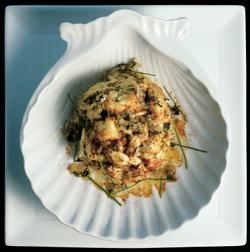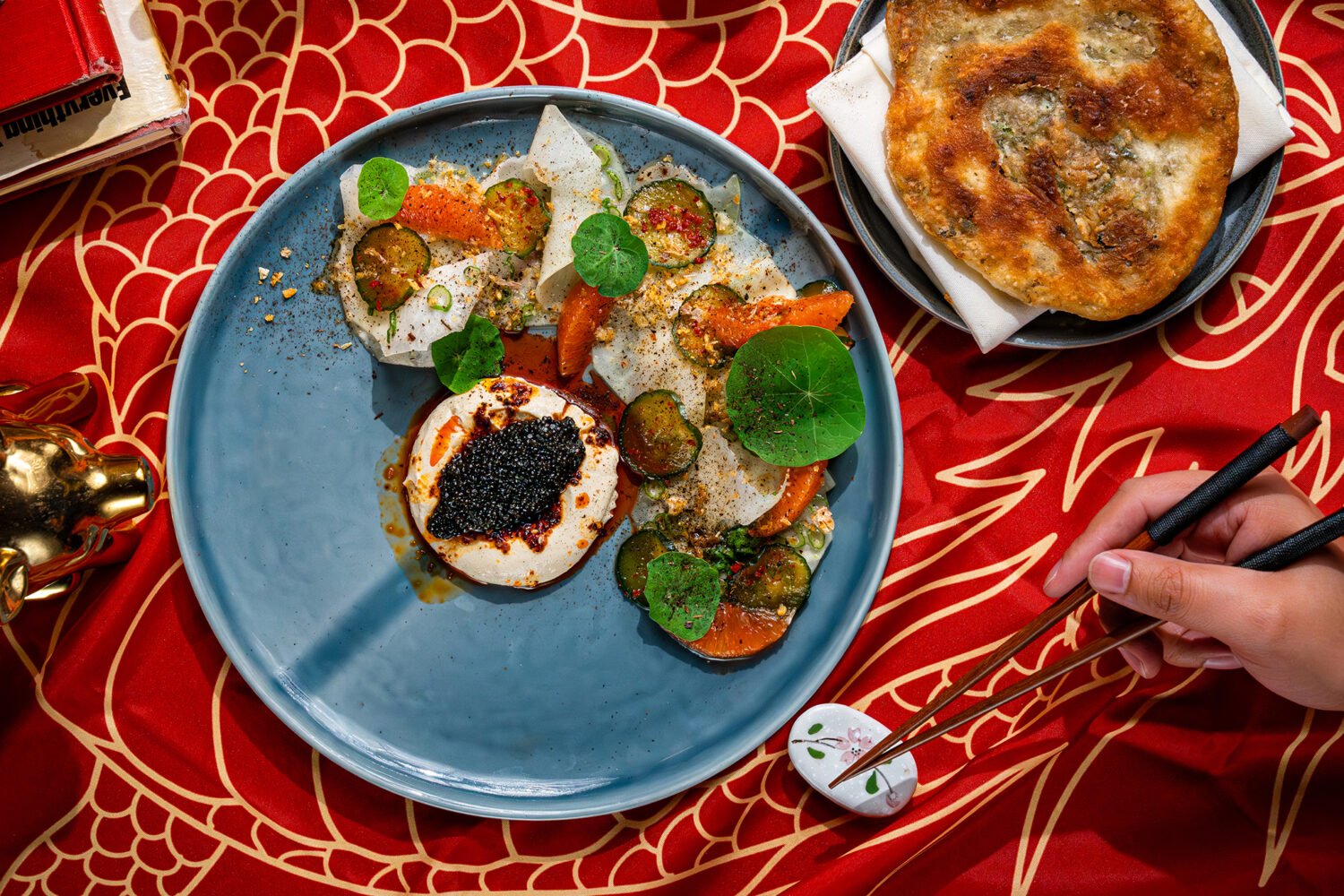
Ray’s the Steaks made its name by serving up big slabs of grass-fed Hereford beef in a bare-walled space with slightly more charm than a train-station bathroom. Its fans overlooked the austerity of the setting, believing its steaks and heaped skillets of mashed potatoes and creamed spinach were pleasure enough, and turned the Arlington cafe into a cult destination. Owner Michael Landrum watched over the proceedings like a bemused guru, making the rounds in a Hawaiian shirt and with a surfer-dude smile, dispensing free slices of Key-lime pie.
Landrum employs no publicist, maintains no Web site, and spurns advertising. The best dishes on the menu do not depend on artful plating or delicate saucing. They don’t rely on a waiter’s elaborate explication to make clear what you’re eating.
Given the self-promoting sideshows that many ambitious restaurants stage to capture our attention, it was initially hard to know if this stripped-to-the-essentials tack represented a daring refusal to play the game—or simply a lack of capital.
Now we know.
For his long-awaited sequel, Landrum has installed himself in the Lee Building on Colesville Road in Silver Spring, the site of the legendary Crisfield’s. He has donned a suit and tie and installed rich brown carpets and booths, white tablecloths, and handsome wing chairs built with the understanding that people who go to restaurants might not all be starved models. There are still bare white walls and thin dangling lights, but at night, with the electronic ticker from the AFI Theatre flickering against the windows and the sounds of Ella and Frank filling the air, the place evokes a stripped-down supper club—the Cotton Club by way of Ikea.
The Silver Spring setting is grander, and so, too, is the mission. Not only is Landrum not playing the game, he seems bent on rewriting the rules.
Open the menu. The retro-styled facade might prime you for retro chic, but if Landrum has his way, a new term will pass into the lexicon: reactionary chic. It’s not just the homage to cocktail hour—shrimp cocktail with fresh grated horseradish, a rendition of deviled eggs (the usual mayo-ed yolks have given way to beef tartare), olives tucked into little mounds of puff pastry, crispy battered sweetbreads made to look like elegant finger food.
It’s the prices. The most expensive thing on the list is the crab fritters, at $8. When you consider that eight bucks is on the low end of most appetizers in a white-tablecloth setting, that most restaurants charge double digits for imported crab when Ray’s serves better crabmeat from Maryland, it’s astonishing. The baked olives are $3; the drop biscuits, fluffy miniatures studded with andouille sausage, are $4. The deviled eggs are $5. T.G.I. Friday’s can’t match that price structure, much less the exactitude and imagination of the cooking.
All meals come with a complimentary salad, an old-fashioned gesture that almost nobody makes anymore. And no wan iceberg, wedge of tomato, and thick-cut cucumber, either. Dandelion greens are slicked with a sweet, tart lemon dressing and sprinkled with crispy smoked bacon; the updated Waldorf salad is bursting with fresh fruit and easy on the mayo; the Caesar is enlivened by good shavings of Parmesan and, in place of croutons, a kind of crispy tater tot flavored with anchovy.
Of the 148 bottles on the wine list, half are $50 or less, and a good many are under $30. Many restaurants mark up their wines three and sometimes four times beyond what you’d pay retail—the $45 bottle you spring for is roughly equivalent to the $12 bottle you opened to go with that plate of spaghetti at home. Here you’re paying, at most, twice the cost.
You might suspect the owner was living in a time capsule if you didn’t catch the clue in the twinned epigraphs that precede the list of Champagnes. The first is a witty paean to drink from Madame Bollinger, the grande dame of bubbly. The second? A lyric from Christopher Wallace, a.k.a. Biggie Smalls, the slain gangsta rapper.
The prices, the accessibility of the food, and the sly cultural codes all account for the mingling of extremes in the dining room, where businessmen in suits and ties sit alongside guys in sneaks and shirttails, where families with little kids are fussed over by the staff as much as the dudded-up couples on dates. The mix feels so relaxed and easy, you wonder why more restaurants don’t make the effort to bridge the divide.
All the egalitarianism in the world wouldn’t matter, of course, if the food weren’t good.
It is. Often, it’s even better than good. Michael Hartzer, a former chef de cuisine under Michel Richard at Citronelle, runs the kitchen with aplomb, finding the natural intersection between his classical French training and the hearty comfort food that Landrum champions.
He transforms a nutmeg-scented creamed spinach into a souffle, pairs a gorgeous double-cut pork chop with a perfect dice of apples and a pool of cider-dijon sauce, makes spaetzle into something light and delicate, displays his mastery of spices in a thick, almond-flecked carrot soup—even turns out a mean chopped chicken liver. His fried chicken is a marvel. Soaked in brine, then buttermilk, then fried to a mahogany-colored crispiness, the white meat is so juicy it could make believers out of all those who swear by dark meat.
Because Ray’s menu is careful to balance its many constituencies, and because Landrum is intent on reviving the spirit of the old-time chop house, Hartzer’s talent doesn’t flourish as it might elsewhere. He’s like a natural, intuitive athlete obliged to work within a team concept. Most diners won’t care that his skills are sublimated to the needs of the larger operation—not when he’s firing steaks as hefty, properly charred, and full of juice and savor as anything you’d get in the big places with bigger reputations, or improving upon the legendary crab bomb at Jerry’s Seafood in Lanham, a softball-size mound of pure jumbo lump crab. Jerry’s has been using jumbo lump crab from Venezuela of late and mixing in more mayo. The jumbo lump in Ray’s Crab Royale is from Maryland, and Hartzer binds the ten ounces of sweet, white meat with nothing more than a sherry-butter sauce.
The missteps are few, but all the more glaring. A veal chop languished too long on the grill one night, emerging with less of the desired char and more of a burn. A saute of halved grapes proved a too-sweet match for an otherwise fine piece of line-caught salmon. And the staff, though attentive and full of enthusiasm, has yet to find its rhythm. The pacing is sometimes off—salads arrived one night before we had finished our appetizers, and there were odd lags on several visits.
By the time dessert arrives, these lapses are mostly forgotten, swept away by the waves of nostalgia induced by Leigh Weinfield’s sweets. There’s not a clunker in the bunch. And some, like the superb apple charlotte (with its intensely buttery Wonder Bread shell), the big wedge of fluffy coconut cake, or the biscuits with strawberries and fresh cream, are as good as anything being done in the area.
The kicker? Each is just five bucks.
At one dinner, a friend of mine speared a forkful of chocolate cake and asked, “Can this place be making money when it’s charging these kinds of prices?” He smiled. “Not that I’m complaining.”
None of us is. But Landrum’s obvious price busting, like his less-obvious cultural button pushing, has implications beyond the cost of a night on the town. If he can smooth out the kinks, and if Ray’s the Classics can fulfill its promise and become not just an important restaurant but a great one, then serving up terrific value and honestly prepared food in a white-tablecloth setting that welcomes black and white, young and old, moneyed and not may become as trendy as small plates and chi-chi lounges. What a radical idea.
-November 2006













